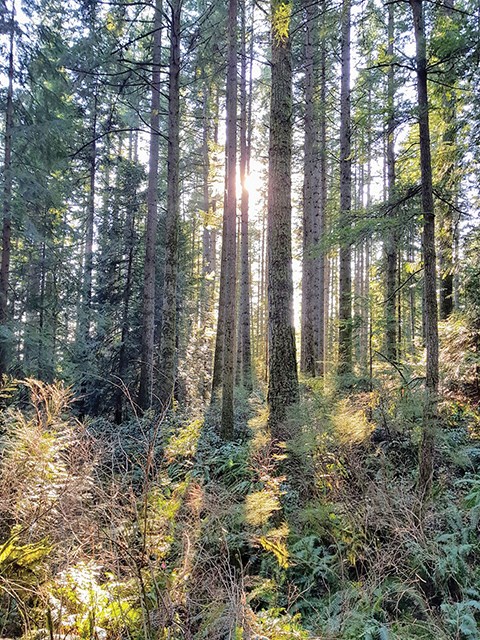Hermann Ziltener, professor emeritus, Department of Pathology UBC, guest writes this week’s column about Reed Road Forest. A retired immunologist who directed a research lab at UBC for over 30 years, he and wife Susanne have been living across from the forest for 12 years and serve on a committee dedicated to saving this lovely, natural forest.
COVID-19 has not only affected all of us personally, but has had an impact on our environment. In the case of Reed Road Forest it has a positive effect; living next to this beautiful forest we noticed once our parks were closed, many more people came to visit the western end of Reed Road and venture into this healthy 120-acre forest, our Elphinstone treasure.
The forest, at the urban-forest boundary, is one of few remaining mature forests in our area that can be easily accessed. Never significantly logged, it regenerated naturally after the big fire of 1906 and is a good example of a mature forest with mixed firs and cedars and well-developed plant communities typical for a maritime forest. The diversity in trees present at all levels of maturity, offers healthy habitat that supports native animals and plants. Over the last years, volunteers have improved several hiking trails into the forest.
Walking these trails, there is always something new to discover and observe. After reading Peter Wohlleben’s fascinating book, The Hidden Life of Trees: What They Feel, How They Communicate, we personally see the forest with different eyes. This book should be a must-read for all foresters as well as part of the school curriculum in B.C., as our province is heavily (if not too heavily) exploiting our forests by simply cutting down trees and re-seeding to create tree farms that lack ecological integrity.
A significant portion of the Gibsons Aquifer water supply runs below the area. In fact, Reed Road Forest was labelled the old Gibsons water reserve. About 20 years ago the Liberal government removed this term that up to then had provided protection for this forest. In consequence BC Timber Sales (BCTS) incorporated this forest into its tree inventory in 2013 and there is now a continued, real danger that Reed Road Forest might be destroyed. BCTS has indicated that they are planning to release over 50 per cent of the timber for clearcut logging; despite repeated opposition from our local government and strong protests from the community.
Currently, a group of residents, together with the Elphinstone Community Association and the Sunshine Coast Conservation Association, is exploring the options of turning this forest into a conservation area and teaching forest. The aim is to protect and leave it mostly as is and develop better trails that could significantly add to the local trail system. The group hopes that the teaching aspect of this forest will contribute meaningfully to public understanding of ecosystem biodiversity, conservation, the value of wildlife corridors, water retention, carbon capture, soil health and human health and wellbeing.
As is often the case in life, we need to stand up and make our interests and values known. The Save Reed Road Forest group, local residents and many others would appreciate your support for protecting this beautiful community asset. Write to our political leaders and let them know you care!
Thanks to Hermann for this! The Elphinstone Community Association has planned a community picnic to be held on the grassy area behind Frank West Hall on Saturday, Aug. 15 from 4 to 7. Bring your own food, utensils, chairs and come out to our Together Apart Community Picnic! Groups from different “bubbles” are asked to stay two metres apart. For community news, contact me at: [email protected]



